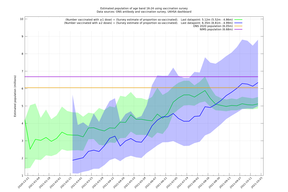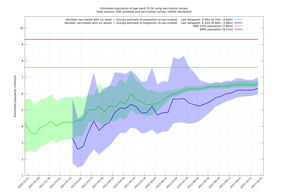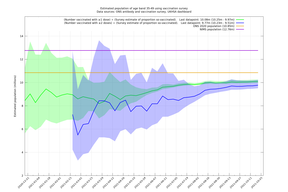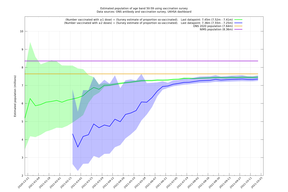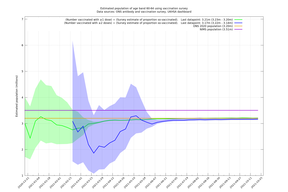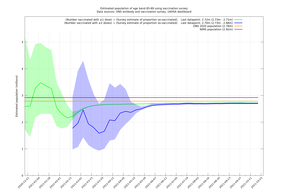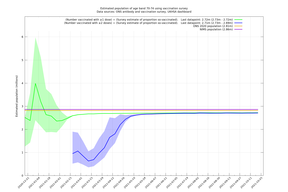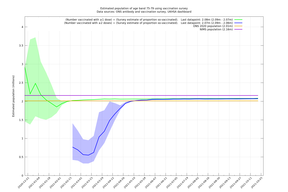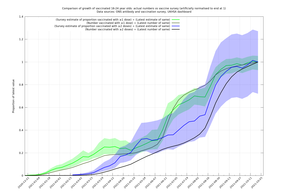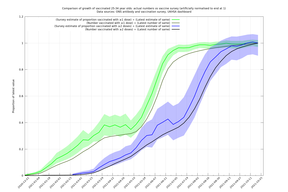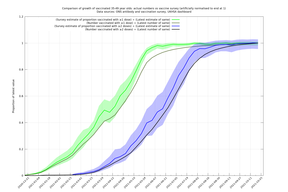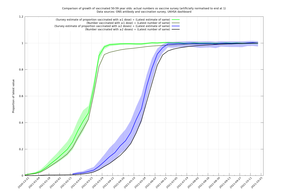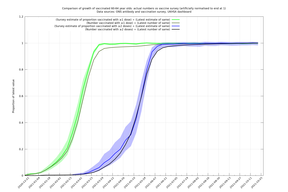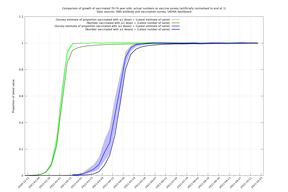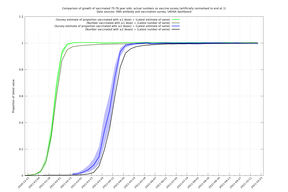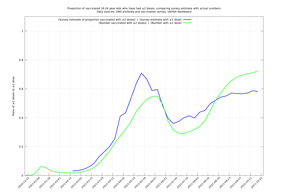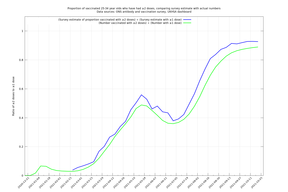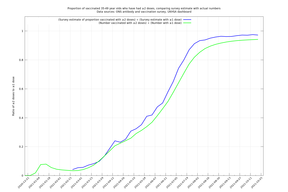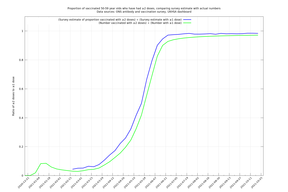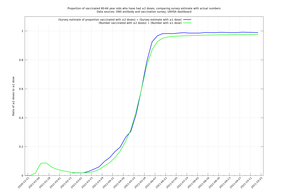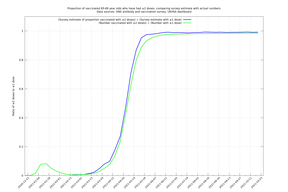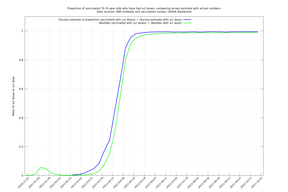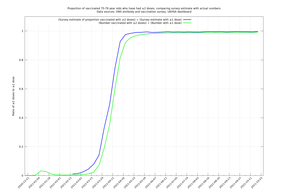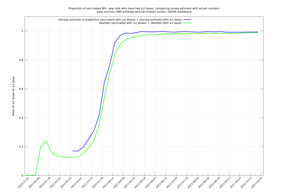Difference between revisions of "Population estimation using vaccine survey"
| Line 31: | Line 31: | ||
| 80+ || 2.83 || 2.86 || 2.73 ( 2.72 - 2.75 ) | | 80+ || 2.83 || 2.86 || 2.73 ( 2.72 - 2.75 ) | ||
|} | |} | ||
| + | |||
| + | By the way, you can think of this is an example of the capture-recapture method of estimation. This is a [https://www.youtube.com/watch?v=tyX79mPm2xY great explanation from Johnny Ball]. | ||
= The Problem = | = The Problem = | ||
Revision as of 05:13, 21 December 2021
Estimation of population in England in certain age bands using the ONS vaccine survey
The table below shows the main estimate. The "Vax Survey" column is obtained simply by dividing (i) the number of people in the age band known to have been vaccinated with at least one dose by (ii) the most recent estimate of the proportion of people in that age band that have been vaccinated with at least one dose. This vaccination survey-derived estimate is certainly not incontestable but it provides an independent extra datapoint, one which generally tends to support the lower ONS 2020 population estimates over the NIMS population figures.
The source for (i), and also the ONS 2020 and NIMS population estimates, is NHS vaccine data or equivalently the Coronavirus dashboard using the metric "vaccinationsAgeDemographics", and the source for (ii) is the vaccine survey part of the ONS Coronavirus Infection Survey, table 1g.
| Ages | NIMS (millions) | ONS 2020 (millions) | Vax Survey (millions) |
|---|---|---|---|
| 16-24 | 6.68 | 6.05 | 5.12 ( 4.86 - 5.52 ) |
| 25-34 | 9.31 | 7.60 | 6.59 ( 6.44 - 6.79 ) |
| 35-49 | 12.76 | 10.85 | 10.08 ( 9.97 - 10.25 ) |
| 50-59 | 8.36 | 7.64 | 7.45 ( 7.41 - 7.52 ) |
| 60-64 | 3.51 | 3.20 | 3.21 ( 3.20 - 3.23 ) |
| 65-69 | 2.92 | 2.78 | 2.72 ( 2.71 - 2.73 ) |
| 70-74 | 2.86 | 2.81 | 2.72 ( 2.72 - 2.73 ) |
| 75-79 | 2.16 | 2.01 | 2.08 ( 2.07 - 2.09 ) |
| 80+ | 2.83 | 2.86 | 2.73 ( 2.72 - 2.75 ) |
By the way, you can think of this is an example of the capture-recapture method of estimation. This is a great explanation from Johnny Ball.
The Problem
The problem is, we don't know very accurately how many people there are in the country. Why is this a problem for managing Covid-19? Because we really want to know the number of unvaccinated people.
Need to know how many at risk: affects modelling, policy, planning. Need to know how well vaccines work.
https://www.ft.com/content/125fbaf8-175a-4e2e-852a-9995ca5176b2
https://www.covid-arg.com/post/vaccine-effectiveness-and-population-estimates
Other stuff
Can see how the estimate evolves over time. Should in theory be constant, but . Potentially get a better estimate out of it.
Discussion of accuracy of vaccination survey-based population estimates
- Survey not finding people; willingness to take part in survey may be correlated with willingness to have vaccine. Partly this is accounted for on post-stratification, but potential dark matter. Tendency from this mechanism would be to underestimate population.
- People dying between being vaccinated and today
